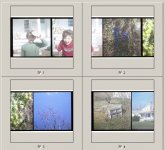hans voralberg
Veteran
I took that Epson scan^ and edited in photoshop to get the best possible result. I also took my Walmart scan and got the best possible result in photoshop. Here are the end results.
http://img171.imageshack.us/img171/8084/comparesx5.jpg
(you may have to click on the picture somewhere to see it full size)
The Walmart scan is on the left and the Epson V500 scan on the right. If you look at the subjects face, you can see that difference I am talking about. The Walmarts scan is crystal clear and the pixels look clean and organized. The Epson scan just looks horrible if you look close at the face.
This is truly a very dissapointing thing for me to find out about my scanner.
I'm not as convinced as you are, actually I'm convinced otherwise. The sample is bloody small and honestly, except sticking a loupe to the screen I cant see any different in your "grain" or "sharpness". The Walmart scan actually has more blown hightlight.
And it appears that you're trying to push alot out of the original scan, what setting for the PS USM are you using ?




